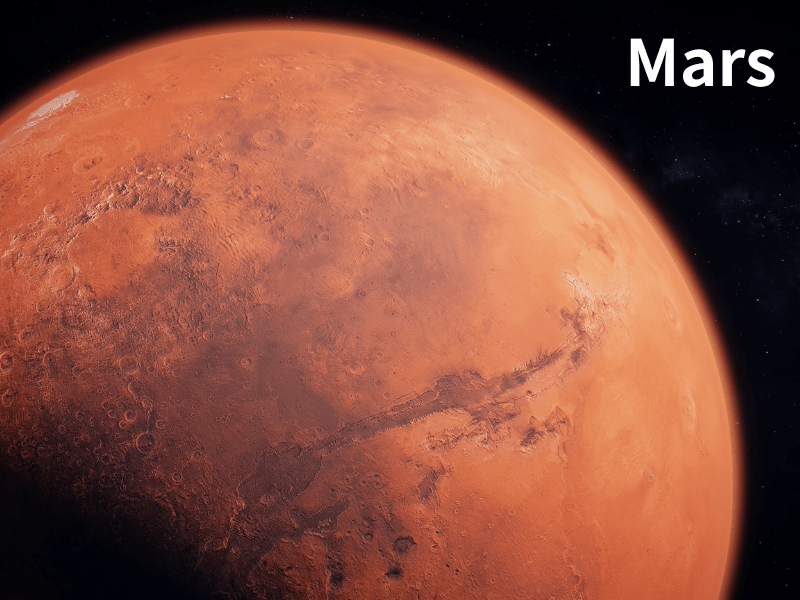
Mars - A Red Basaltic World with Traces of Granite
Share
Origin & Age
Earth is 4.6 billion years old; Mars formed about 4.5 billion years ago. Once home to rivers and lakes, Mars still preserves water ice beneath its surface. Its reddish color comes from iron in basalt that oxidized into rust, spreading across the planet.
Mars Specs
| Item | Value | Versus Earth |
|---|---|---|
| Age | ~4.5 billion years | Slightly younger |
| Diameter | 6,779 km | ~0.53× Earth |
| Mass | 0.11 Earth masses | — |
| Gravity | 0.38 g | ~1/3 Earth |
| Mean surface temp. | −63°C (min −125°C / max +20°C) | Colder |
| Atmosphere | Thin CO₂ (~95%) | Not breathable |
| Can humans move bare-skinned? | No (low pressure & hypoxia fatal) | Impossible |
| With spacesuit? | Yes (planned EVAs possible) | Feasible |
Main Rocks on Mars
| Rock | Key traits | Exists on Earth? | Uses (material) | Major sources (Earth) |
|---|---|---|---|---|
| Basalt | Volcanic, Fe-rich; on Mars, weathered to reddish by oxidation | Yes, very common | Aggregates, road base, rock wool | Japan (Fuji, Aso), Hawaii, Iceland |
| Sandstone | Sedimentary rock formed by water & wind | Yes | Building stone, decorative stone | US (Arizona), India, Australia |
| Volcanic tuff | Compacted volcanic ash deposits | Yes | Pumice blocks, gardening | Japan (Aso, Izu-Oshima) |
| Granite-like (trace) | Si-rich, differentiated; found locally by Curiosity rover | Yes, abundant on Earth | Monuments, lanterns, sculptures, gravestones | Japan (Okazaki, Kagawa), China (Fujian), India, Brazil |
Granite Traces on Mars
NASA’s Curiosity rover and Martian meteorite analyses revealed granite-like rocks. These silica-rich rocks likely formed when basalt partially re-melted and differentiated. However, without stable water and plate tectonics, Mars could not create granite on continental scales. Thus granite remains trace-level only.
Red Plains from Iron Oxides
Mars is red because iron in basalt oxidized into hematite and other oxides. Unlike Earth, where red soils are local, Mars has oxidized globally due to its dry, thin atmosphere.

Environment & Human Activity
Mars is frigid and has a thin CO₂ atmosphere. Bare-skin activity is fatal, but with spacesuits, limited EVAs are possible. Rovers like Curiosity and Perseverance continue searching for signs of past water and possible biosignatures.
Contrast with Earth
Mars is mainly basalt and sedimentary rocks with only traces of granite. Earth, thanks to water and plate tectonics, developed granite continents—the foundation of human civilization.
Summary
- Origin: ~4.5 billion years ago, once hosted rivers and lakes
- Composition: basalt, sandstone, tuff, with granite traces
- Environment: bare-skin no / spacesuit yes
- Granite never reached continental scale due to lack of water & plates
On Mars, granite exists only as faint traces. It can never produce the granite products sold by japanstones.shop.
Related Articles (Planet & Stone Series)
- The Sun — A Fusion Star Without Granite
- Earth — Granite, Water, and a Breathable Atmosphere
- The Moon — A Fork After the Giant Impact
- Mercury — An Iron World That Resembles the Moon
- Venus — A Basalt World, Granite Hints of Ancient Water
- Mars — A Red Basaltic World with Traces of Granite
- Jupiter — A Rockless Planet, Earth’s Giant Shield
- Saturn — Rings Without Granite, a Jupiter-like Gas Giant
- Uranus — A Tilted Ice Giant, Gentle Twin with Diamond Rain
- Neptune — Diamond Hurricanes, Blue Storms, No Granite
- Pluto - Icy Dwarf Planet at the Solar Edge, No Granite
